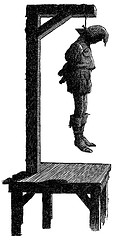Hypothermia victims are often found with clothing removed, as if they’ve been assaulted. It’s not clear why a freezing person would undress; possibly their judgment is impaired, and possibly exhaustion brings a sensation of warmth to the skin.
“A Rare Circle of Friends”
Sir Henry Blackman, of Lewes, on being knighted in 1782, gave a dinner to sixteen friends, with an invitation to them to dine with him annually for forty years; four of them died during the first four years, but twenty-eight years rolled round before another seat became vacant at the festive board. In 1814 two died, aged between eighty and ninety; so that ten remained of the original number at the thirty-third anniversary, held in July, 1815!
— Curiosities for the Ingenious, 1825
Subtraction Pangram
Each term in this equation contains each of the nine digits once:

Careful!
Before conductors used batons, they kept time by banging a long staff against the floor. In January 1687, Jean-Baptiste Lully was conducting a Te Deum in this way when he struck his toe. The wound turned gangrenous, the gangrene spread — and he died.
Letter Shift

Mind Your Money
A cold coin placed on the forehead feels heavier than a warm one.
An Alarming Paradox
In 1735, an anonymous “lover of mathematicks” offered the following conundrum:
“‘Tis certainly Matter of Fact, that three certain Travellers went on a Journey, in which, tho’ their Heads travelled full twelve Yards more than their Feet, yet they all return’d alive, with their Heads on.”
How is this possible?
“A Singular Coincidence”

On the 13th of February 1746, as the records of the French criminal jurisprudence inform us, one Jean Marie Dunarry was brought to the scaffold for murdering his father; and, strangely enough, on the 13th of February, 1846, precisely one hundred years later, another Jean Marie Dunbarry, a great-grandson of the first-mentioned criminal, paid the same penalty for the same crime.
— Frank H. Stauffer, The Queer, the Quaint and the Quizzical, 1882
In a Word
potvaliant
adj. inclined to fight when drunk
Work Smarter, Not Harder
On Dec. 10, 1968, a uniformed man pulled over a bank car in Tokyo. He explained that police had received a warning that dynamite had been planted in the vehicle, which was transporting bonuses for local Toshiba employees. The four passengers got out and watched as the officer crawled underneath.
After a moment he rolled out, shouting that the car was about to explode. When the passengers ran, he got in and drove off.
Thus one man stole 294,307,500 yen in broad daylight, working alone and without harming anyone. It remains the largest single heist in Japanese history. The thief was never caught.
